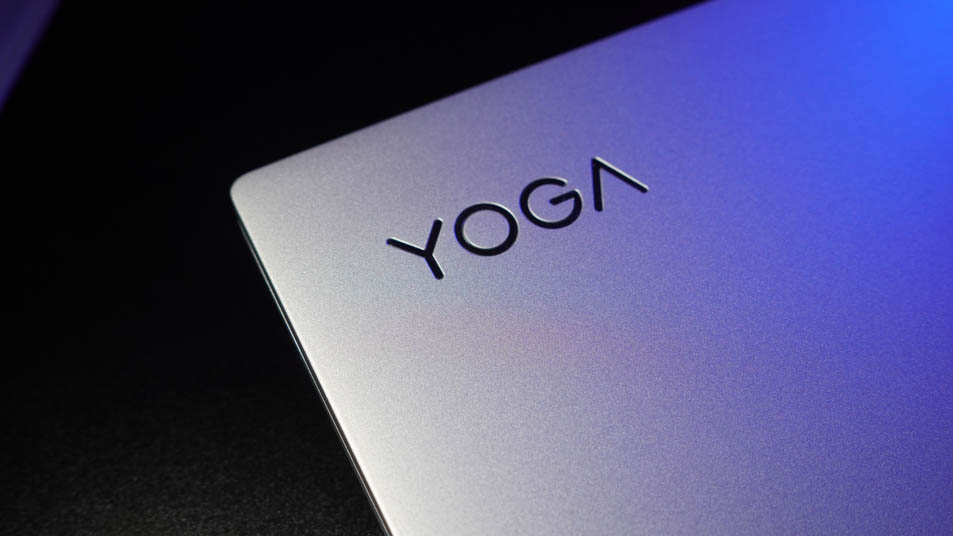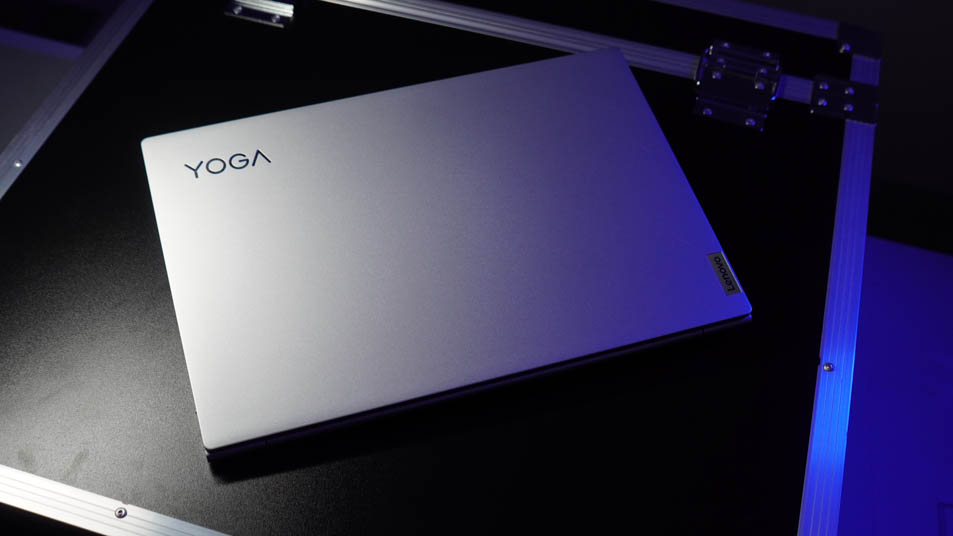The Lenovo Yoga Slim series encompasses various configurations, and the Slim Carbon edition is designed to be premium, lightweight, and sturdy. With the addition of the AMD Ryzen 7 5800U processor to its current lineup of OLED display laptops, like the Yoga Slim 7 Carbon, does it have what it takes to sit at the top of the food chain or just be an aesthetic release from Lenovo? Find out from our full review.

Table of Contents
Clothed with a silver hue that Lenovo calls Cloud Gray, comes a 14-inch slim notebook that measures a sleek 14.9mm thickness. Along with its slender body comes a light and sturdy chassis that weighs a little over a kilogram. The Lenovo Yoga Slim 7 Carbon is consistent with that of its whole series with top-firing speakers as well as carbon fiber with magnesium alloy for the build.

Possibly one of the most minimalist designs out in the market ultrabook market with a simple Yoga logo placed on the upper-right of the laptop’s cover as well as a vertically placed Lenovo logo on the lower-right hand side.

Lenovo has completely let go of the USB-A ports on the Yoga series. Though, unlike most Intel variants, a Thunderbolt port is unavailable. On the left-hand side, the charging LED indicator is present along with 2 USB-C ports 3.2 Gen 2 ports that support DisplayPort 1.4 and PowerDelivery 3.0. Additionally, there is a headphone + mic combo port available.

Moreover, on the right-hand side is the power button as well as the webcam privacy shutter with a USB-C 3.2 Gen 1 port.

Moving over to the center of the main body of the laptop is the keyboard. Lenovo has chosen to opt-out of having the numpad here, and it was a great option as it would have cramped most of the keys.

No complaints here as everything seems to be standard with its accuracy and reception to keypresses. The same goes with the trackpad that has been broadened by Lenovo removing fatigue from clicks and presses.
Upon opening the laptop, we see that Lenovo retains the OLED display and adds 90Hz to its panel. At the top of the display is the notched webcam that is a constant design across the Yoga series. Beside the webcam is an IR sensor that also has the Mirametrix Glance which wakes the laptop upon the detection of a face. This in turn unlocks the laptop via Windows Hello’s face authentication. Furthermore, the OLED display has a VESA DisplayHDR 500 True Black certification.

With the innovation of adding the OLED panels, Lenovo made sure they did not disappoint by equipping the Yoga Slim 7 carbon with a QHD+ resolution together with the 90Hz refresh rate. This brings a better contrast ratio and deeper blacks making it a great companion for any multimedia editors or designers.

Out of the box, the Lenovo Yoga Slim Carbon 14 ACN has a factory-calibrated display panel giving a 100% sRGB, 96% AdobeRGB, 97% DCI-P3, and 95% NTSC color accuracy based on our DataColor Spyder X Pro display analysis.

As an addition to the immersive experience brought about by the OLED display, Lenovo’s front-firing speakers are built for an engrossing audience with its Dolby Vision Atmos Speaker System creating a complete entertainment package for those that are allured by binge-watching or music trips.

At max volume, the Lenovo Yoga Slim 7 Carbon was able to reach a 95.1 dBA level making it a pretty loud laptop with a compact body.

The particular unit we got here today sports a Ryzen 7 5800U paired with Nvidia’s MX450 discrete GPU, along with RAM, 512GB PCIe Gen3 x4 SSD, and a Windows 11 out of the box. To be quite frank, the power of the Ryzen 7 5800U can be felt with this particular laptop thanks to its 8-cores that help it and its SK Hynix SSD 512GB M.2 2280 PCIe Gen3 x4 that really helps it to speed up render times work at the pace of its user.

In order to determine the theoretical capabilities of the Lenovo Yoga Slim 7 Carbon, we subjected it to several tests after getting everything updated. For reference, we are running on Windows 11 Home Version 21H2 OS Build 22000.493 and NVIDIA’s GeForce MX450 running the latest Version 511.79 drivers.
• PCMark 10 Extended – 10,717
• 3D Mark – 1946 (Time Spy), 5,670 (Time Spy Extreme), 4276 (Fire Strike), 1781 (Fire • Strike Extreme),
• Geekbench 5 – 1,259 (Single-Core), 6,099 (Multi-Core)
• Cinebench R20 – 3206 (CPU-Multi), 552 (CPU-Single)
• Cinebench R23 – 8164 (CPU-Multi), 1,448 (CPU-Single)
• CrystalDiskMark 8 (1GiB) – 3590.08 MB/s (Read), 3256.24 MB/s (Write)
Despite the laptop being made for gaming, we couldn’t help ourselves so we tried a few games of Valorant and Dota 2 just to test the capacity of the laptop in terms of suddenly taking a breather in the midst of work. We got decent frames being able to run the laptop at 60fps on medium settings. The capability is thanks to the NVIDIA GeForce MX450 being almost at par with the GeForce GTX 1650 mobile GPU.
Network connectivity is a factor that is normally overlooked when choosing a laptop and with the innovations of technology, the Lenovo Yoga Slim 7 Carbon comes with 2 x 2 WiFi 6 (802.11ax) capable network cards. How does this help in better connectivity? Basically, network congestion is easily solved with this advancement especially when multiple devices are connected. The caveat to all this is that the router and device should have WiFi 6 capabilities.
For battery life, the Lenovo Yoga Slim 7 Carbon’s 61Whr battery was able to last 12 hours with regular use, and multimedia. This was done with about 50% of the brightness, and with standard settings, so it’s more than enough to get you through the day. In terms of charging, it takes about 2 hours to fully charge. About half an hour gets about 20% of the battery up and running.

A purchase of something of this caliber would mean that portability is a priority for the end-user. The Slim 7 Carbon with Ryzen 7 5800U should be able to accommodate a quick edit or a quick report to be made while on the go. Although it was meant primarily for productivity purposes, a little gaming can be done on the side. At PHP 86,995USD 1,482INR 125,673EUR 1,412CNY 10,796, the laptop does its job of being a portable and lightweight device to accommodate basic to intermediate tasks that would be required to be done while traveling. On the downside, since it runs an AMD Ryzen 7, the Thunderbolt capabilities are not present. We would’ve preferred additional USB-Type A ports as an option. Other than that, the Slim 7 Carbon ticks all the right boxes
Lenovo Yoga Slim 7 Carbon 14ACN specs:
14″ QHD + OLED (2880 x 1800), 400 nits
100% DCI-P3, 90Hz, Vesa Certified DisplayHDR 500 True Black
AMD Ryzen 7 5800U
NVIDIA GeForce MX450
16GB LPDDR4X RAM
512GB PCIe NVMe SSD
WiFi 6
Bluetooth 5.1
1x USB-C 3.2 Gen 1 (support data transfer only)
2x USB-C 3.2 Gen 2 (support data transfer, Power Delivery 3.0, and DisplayPort 1.4)
1x headphone/microphone combo
Front-firing Dolby Vision Atmos Speakers
720p webcam
61Whr battery
Windows 11
Lenovo 3 Year Premium Care

YugaTech.com is the largest and longest-running technology site in the Philippines. Originally established in October 2002, the site was transformed into a full-fledged technology platform in 2005.
How to transfer, withdraw money from PayPal to GCash
Prices of Starlink satellite in the Philippines
Install Google GBox to Huawei smartphones
Pag-IBIG MP2 online application
How to check PhilHealth contributions online
How to find your SIM card serial number
Globe, PLDT, Converge, Sky: Unli fiber internet plans compared
10 biggest games in the Google Play Store
LTO periodic medical exam for 10-year licenses
Netflix codes to unlock hidden TV shows, movies
Apple, Asus, Cherry Mobile, Huawei, LG, Nokia, Oppo, Samsung, Sony, Vivo, Xiaomi, Lenovo, Infinix Mobile, Pocophone, Honor, iPhone, OnePlus, Tecno, Realme, HTC, Gionee, Kata, IQ00, Redmi, Razer, CloudFone, Motorola, Panasonic, TCL, Wiko
Best Android smartphones between PHP 20,000 - 25,000
Smartphones under PHP 10,000 in the Philippines
Smartphones under PHP 12K Philippines
Best smartphones for kids under PHP 7,000
Smartphones under PHP 15,000 in the Philippines
Best Android smartphones between PHP 15,000 - 20,000
Smartphones under PHP 20,000 in the Philippines
Most affordable 5G phones in the Philippines under PHP 20K
5G smartphones in the Philippines under PHP 16K
Smartphone pricelist Philippines 2024
Smartphone pricelist Philippines 2023
Smartphone pricelist Philippines 2022
Smartphone pricelist Philippines 2021
Smartphone pricelist Philippines 2020